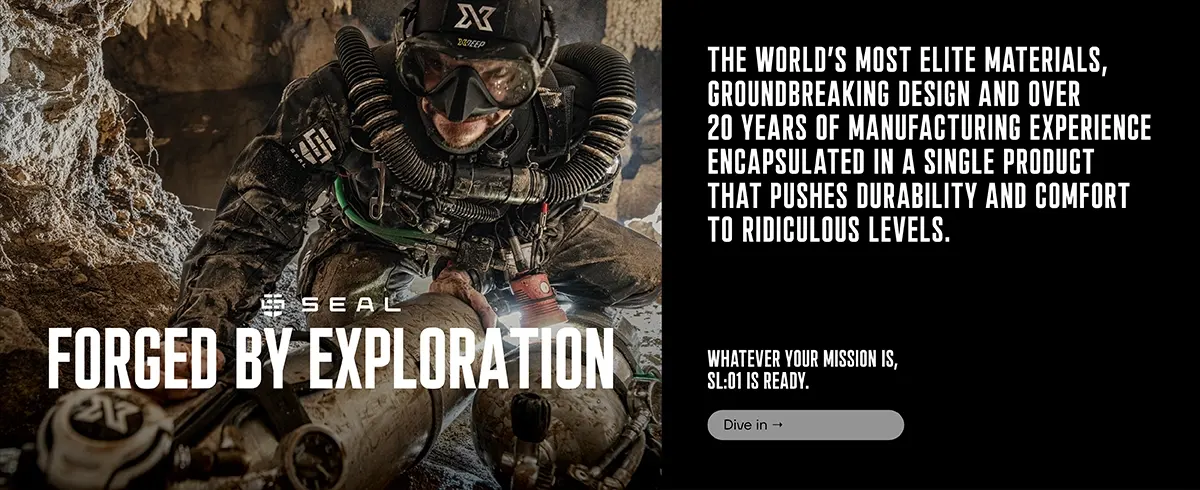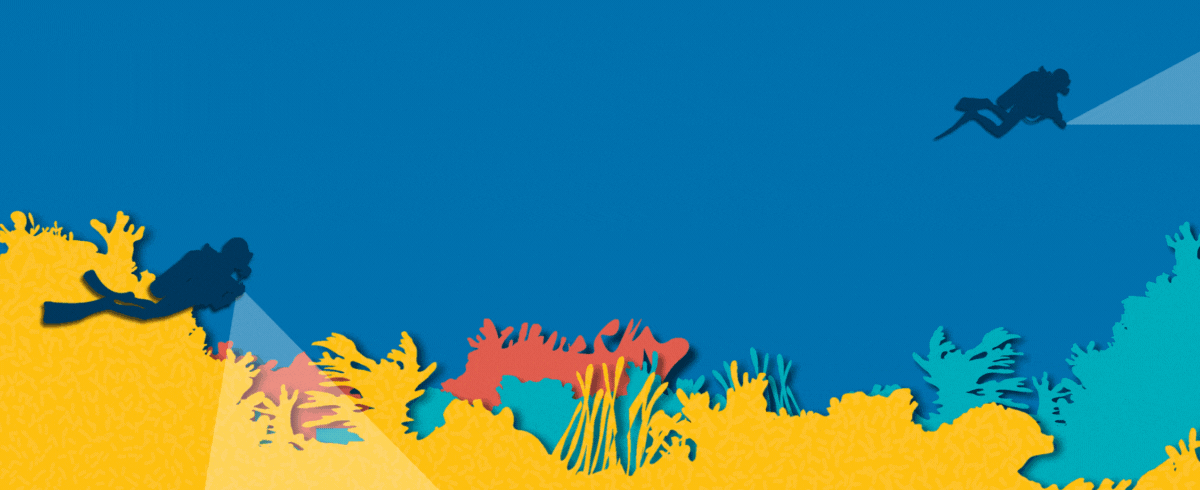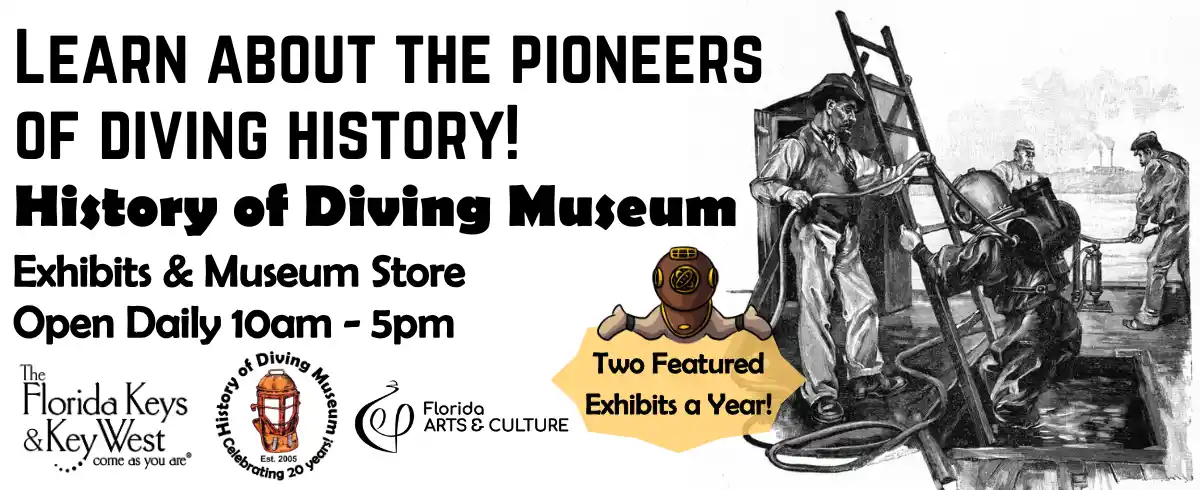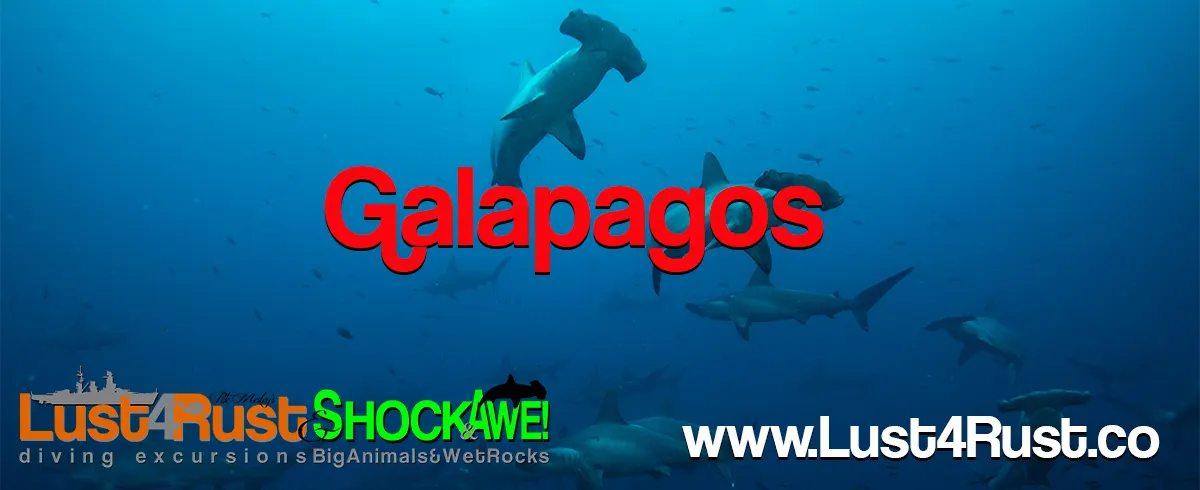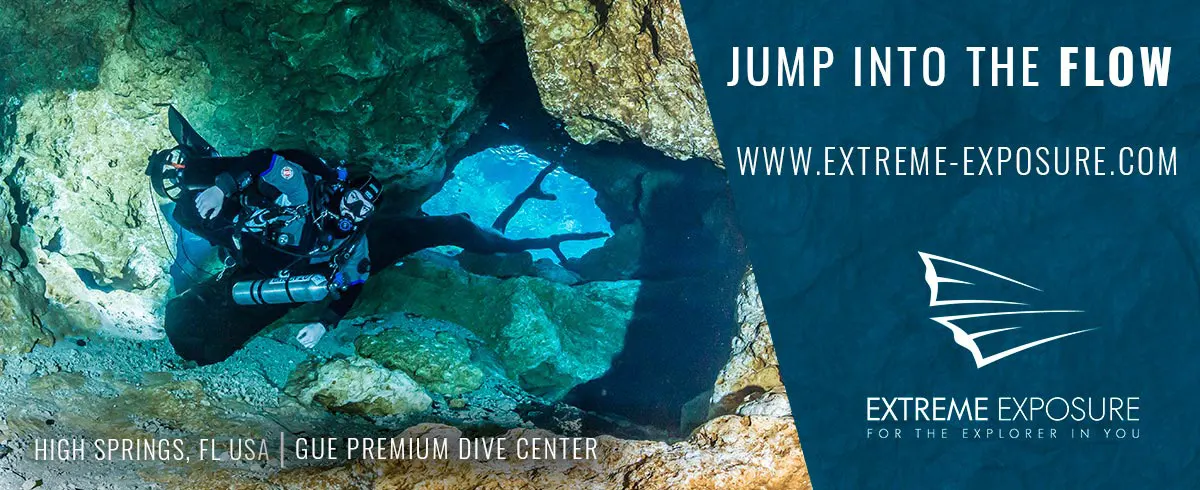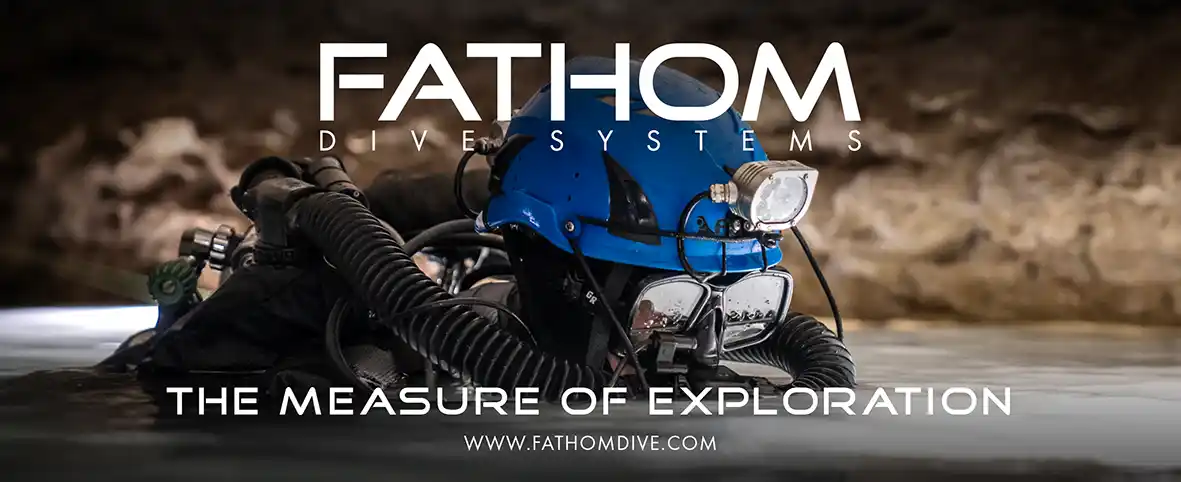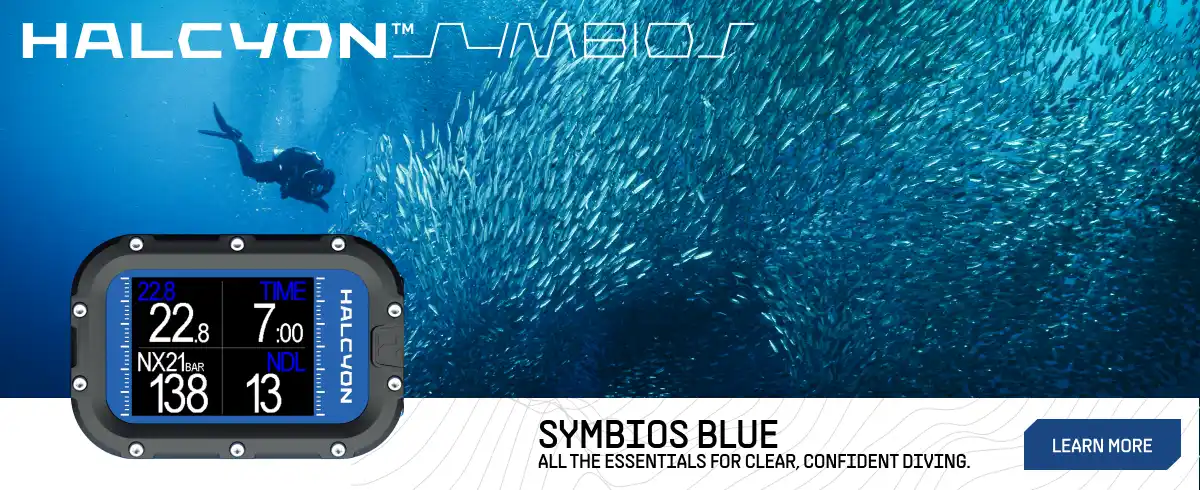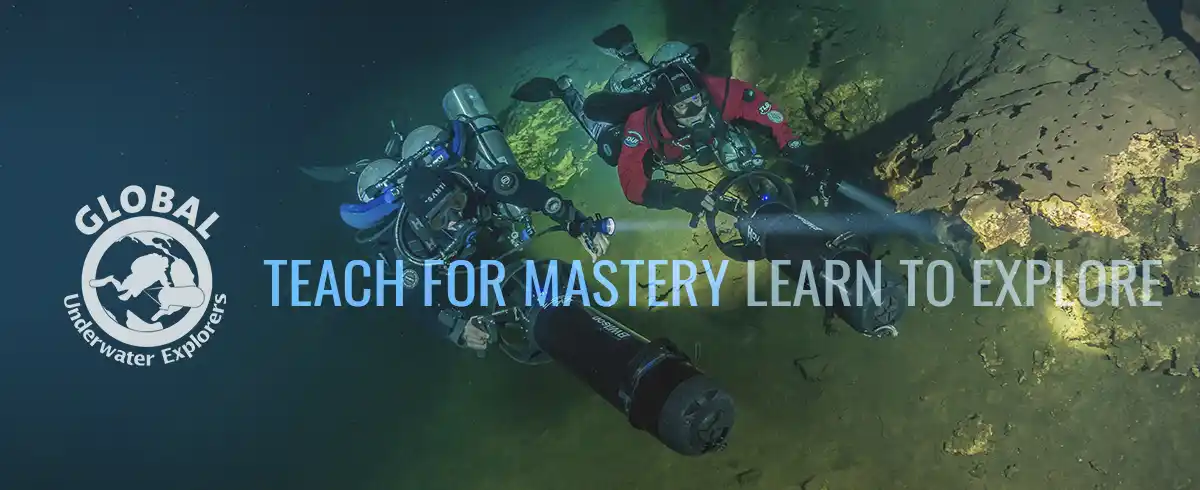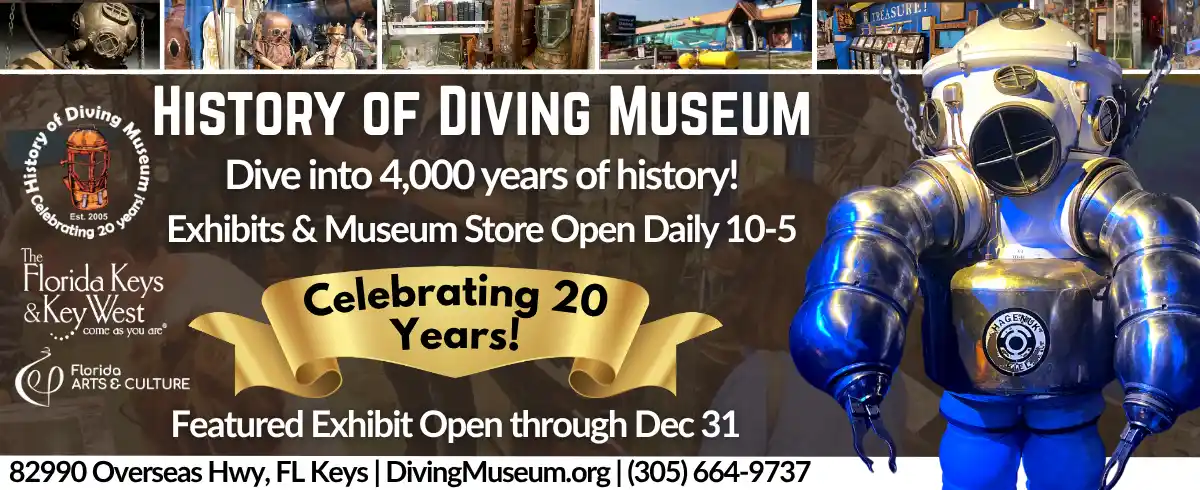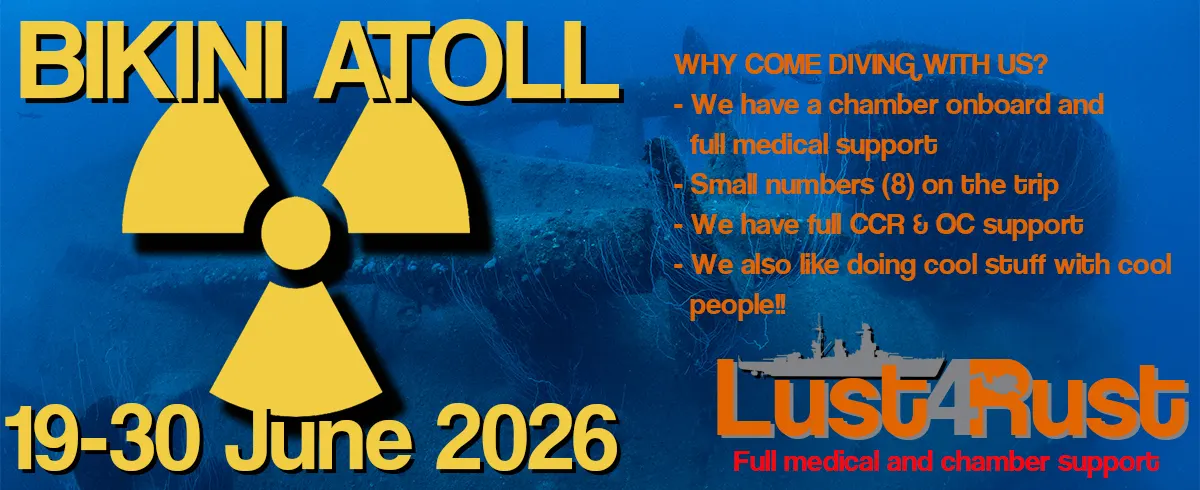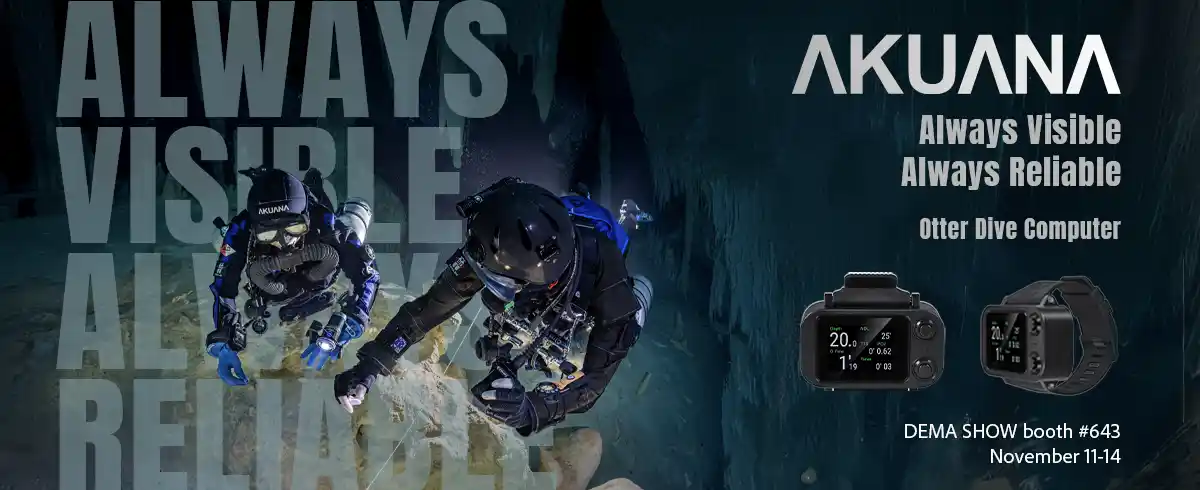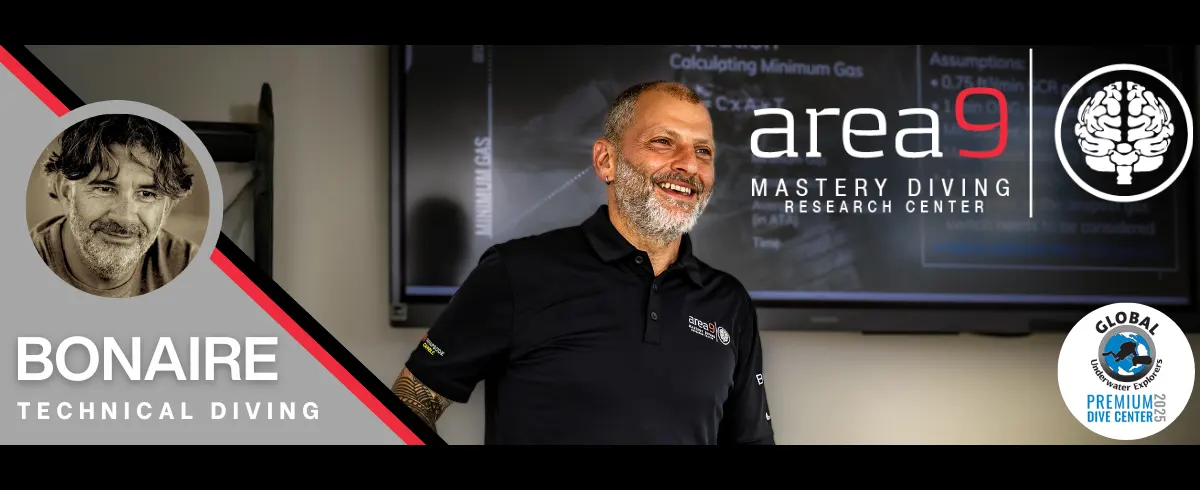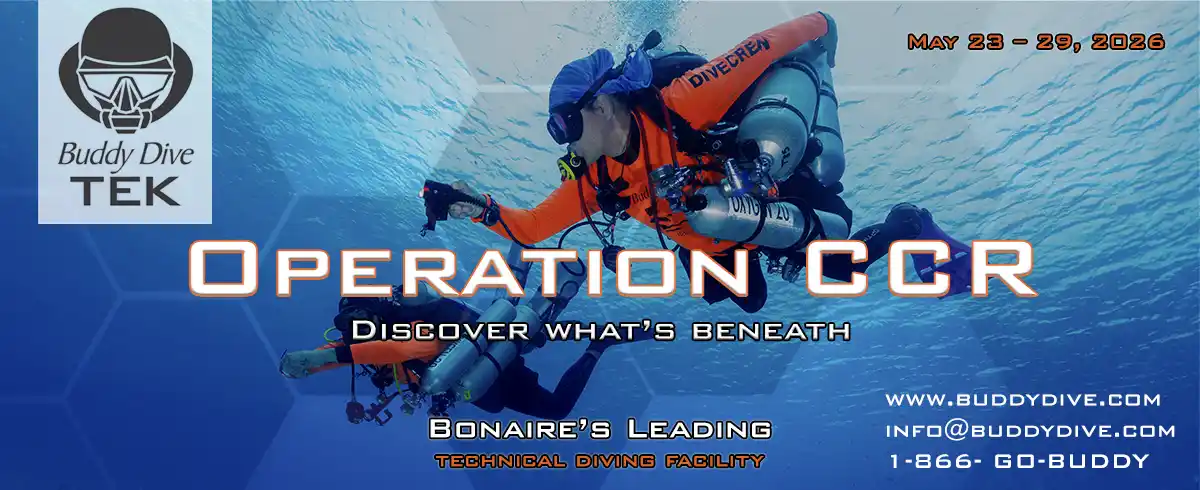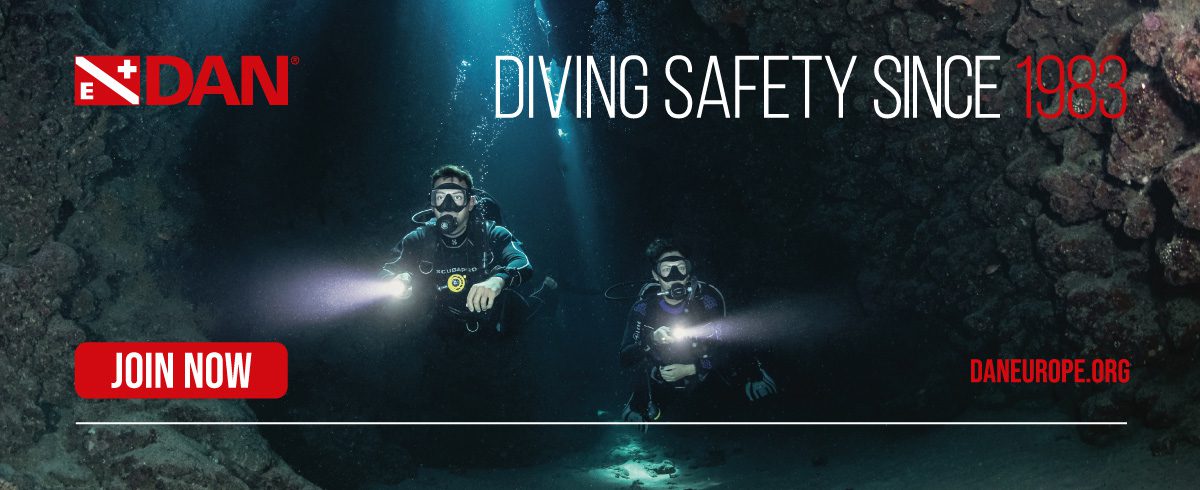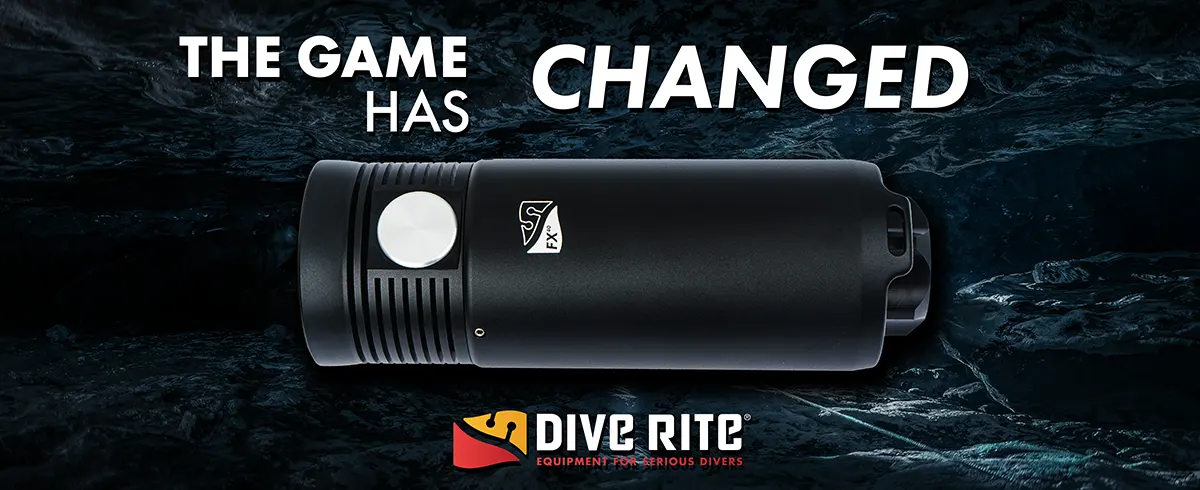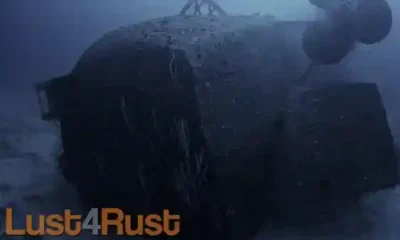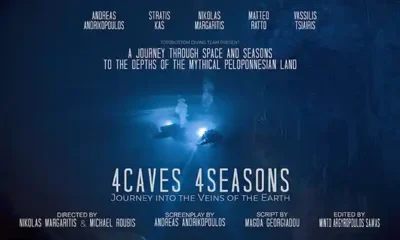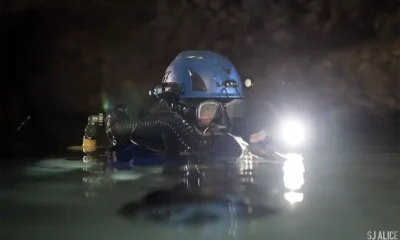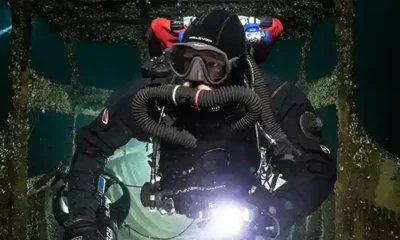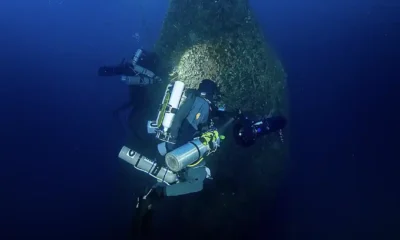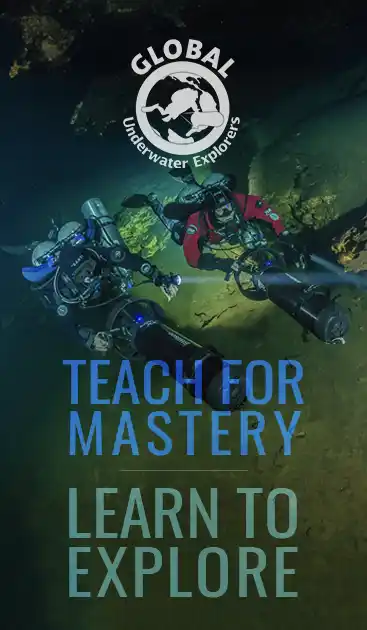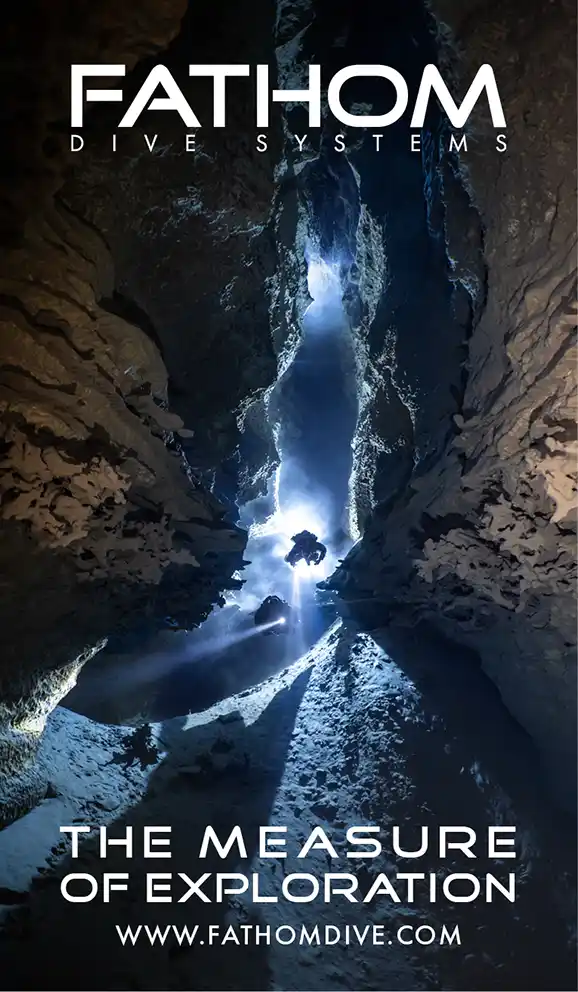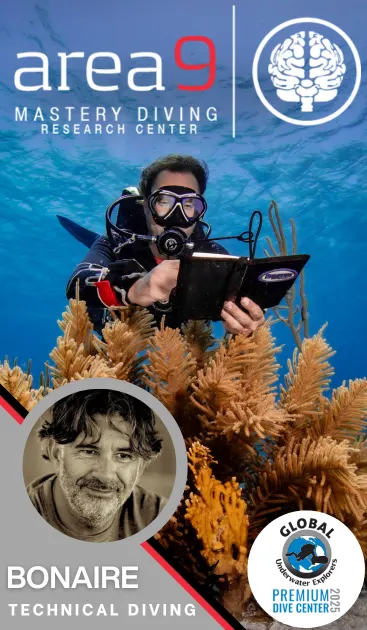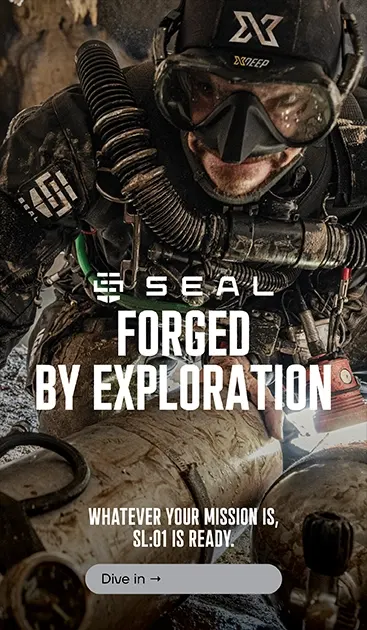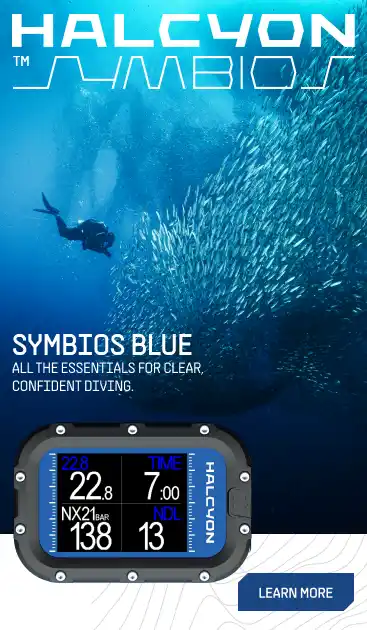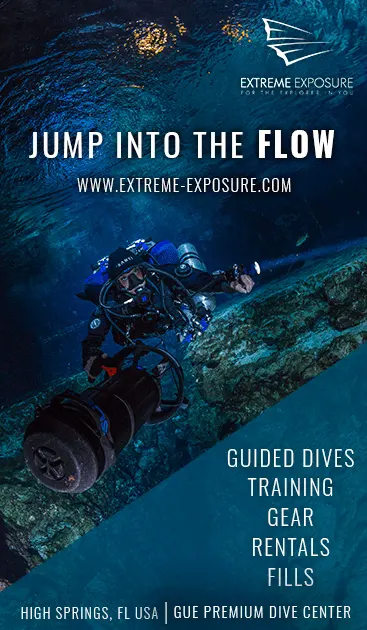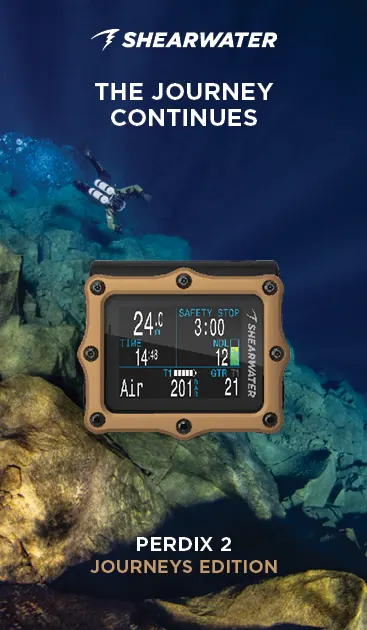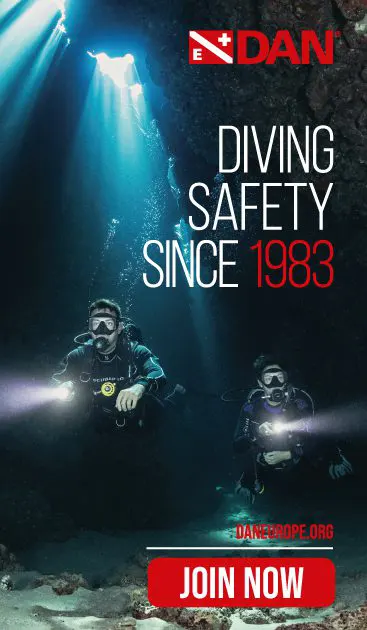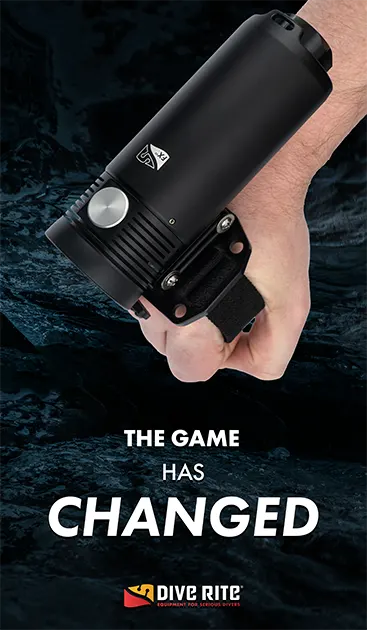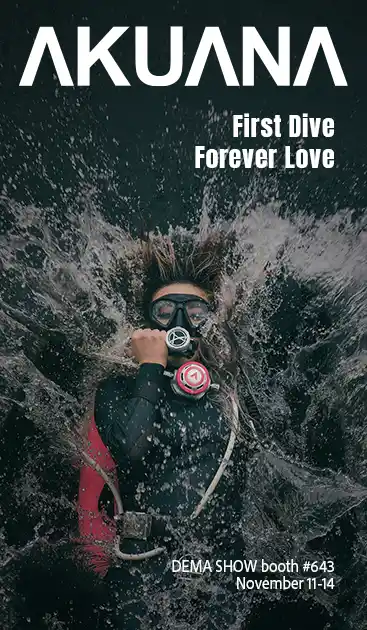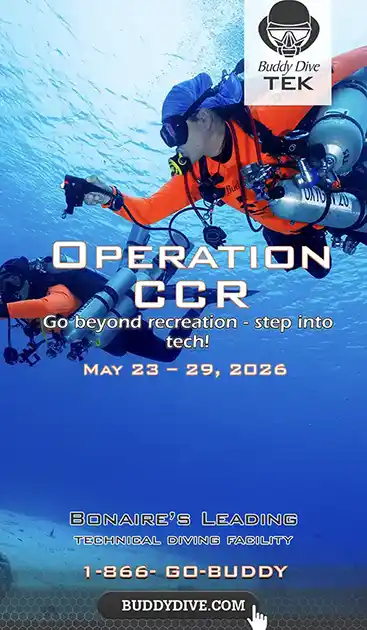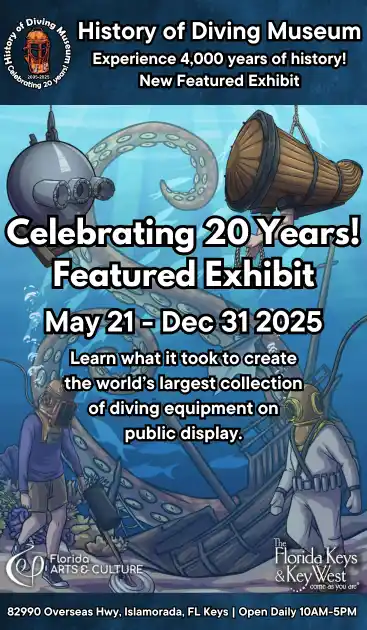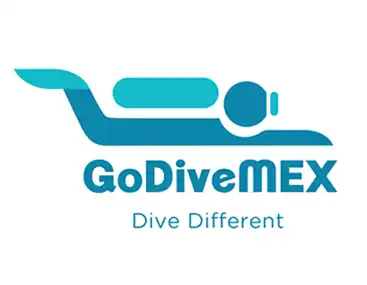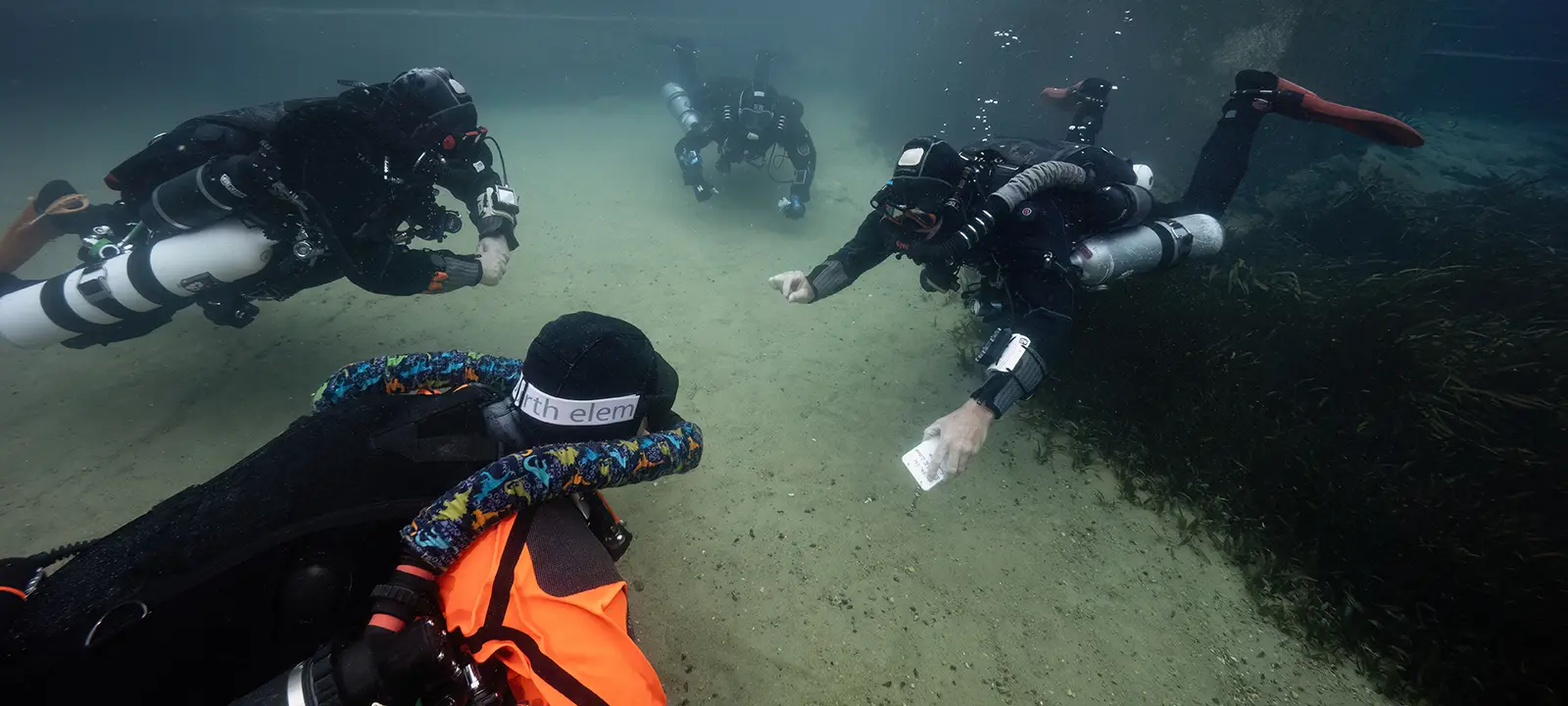
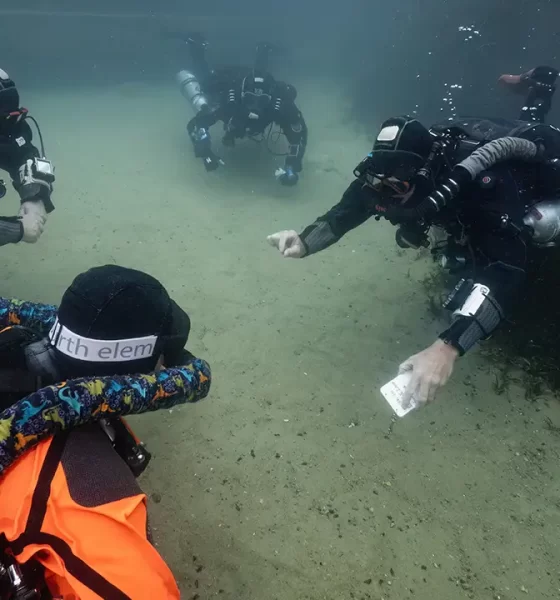
Latest Features
Surviving Edd’s Bubbleless Bootcamp
Dive911 instructors Wally Endes, owner of Dive911, and Christine Tamburri detail their trials, tribulations, and triumphs taking a Sidewinder rebreather class with legendary underground instructor, pioneer, and explorer Edd Sorensen. Better be on your best behavior!
By Christine Tamburri and Wally Endres. Images courtesy of Serafino Bohrer.
So, you’re thinking about getting certified to dive on a rebreather—possibly the KISS Sidewinder. Or maybe you’ve got your eye on training with the legendary Edd Sorenson at Cave Adventurers. Or, perhaps, you’re part of the rare breed who wants to dive into both at once. If you’ve done any research on rebreather training, especially with Edd, you’ve probably heard it likened to military boot camp. (Spoiler alert: It’s not far off.) You’ve also likely come across an internet debate: Is a manual closed-circuit rebreather (mCCR) really tougher to master than an electronic version (eCCR), especially for beginners?
In this article, we will recount our journey through KISS Sidewinder training with Edd Sorenson. Wally Endres came into the course with a bit of rebreather experience, while Christine Tamburri was as green as they come. What follows is a raw, unfiltered account of a deeply rewarding yet brutally challenging experience—served with a side of humor and humility. For now, here is a little foreshadowing:
“I don’t yell at you because I hate you—I yell at you because I like you!” —Edd Sorenson
So, grab a seat, maybe some popcorn, and a notepad (you might need it). Whether you’re a seasoned rebreather diver looking for some entertainment, a future rebreather diver seeking insight into gear and instructors, or a newbie eager to learn about advanced training and equipment, this article has something for you!

The Unsuspecting Victims (…errr….Divers)
Christine Tamburri is an SDI/TDI Instructor, cave diver, and HR professional with almost no mechanical inclinations. Ask her to change a lightbulb, and she can probably get it done; ask her to explain how a solenoid works, and you’ll see her stare off into the distance with the same look of panic you’d expect from someone who just realized they forget to fill their cylinders as they’re pulling up to the dive site. Going into KISS Sidewinder training, Christine’s total rebreather experience clocked in at a staggering 0 minutes and 0 seconds. Her knowledge of rebreathers? Let’s just say it was on par with an average kindergartener’s understanding of quantum physics.
Christine’s interest in rebreathers was sparked early in her dive career as she saw the advantages they provided in reducing time, distance, and gas stress, especially in overhead environments. She chose the KISS Sidewinder because of her love for sidemount diving and because most of her dive buddies already used the unit. Community and post-training support were major factors in her decision, and having a group of friends who knew the unit well was a huge bonus. She did not demo any other rebreathers and knew from the start that, if she was going to train with anyone, she wanted to train with Edd Sorenson. Having already completed Cave DPV training with Edd, she thought she had a pretty good idea of what to expect. (Spoiler: She was wrong.)
Wally is an Instructor Trainer & Course Director for multiple training agencies; he’s also a cave diver and business owner. He’s the fearless co-leader of Dive911, a dive training group that specializes in everything from recreational diving, public safety diving, and heavy salvage. Wally has an incredible mechanical mind and spends his days designing his dream shipping container home, restoring a 1955 Willys Restomod, and fabricating just about anything that comes to mind. If there’s a problem to solve, Wally’s already building a solution in his garage. Wally’s previous rebreather experience included around 30 hours on the Dive Rite O2ptima (backmount), and his rebreather knowledge is slightly above average.
Wally’s interest in diving rebreathers started with an idea to dive Truk Lagoon and Bikini Atoll. However, his plans were thwarted when COVID-19 arrived and put the kibosh on most, if not all, travel. His interest was rooted in deep diving prospects to see some historical wrecks without the extreme cost of open circuit trimix. He did not demo any other rebreathers, although he had plenty of opportunities to do so.
In summary, this is what we were working with:

Rebreather Real Talk: Diving into the Details
We spent a lot of time thinking about how to cram all the juicy details of our rebreather journey into one digestible format. Should we write an epic saga? Maybe a documentary-style narrative? After much back-and-forth, we landed on a good ol’ Q&A format. Why? Because it’s quick, it’s to the point, and, honestly, it forces us to keep it real.
So, here it is: candid answers to the burning questions that shaped our triumphs (and failures) during our KISS Sidewinder training with Edd Sorenson. Buckle up and prepare for some unfiltered wisdom. Things are about to get real. Really real.

What kind of preparation did you do in the weeks/months leading up to class?
CHRISTINE: The short answer? Lots. The long answer? A whole heck of a lot. As soon as I hung up the phone after the initial call to Edd to schedule the class, my preparations began. They started slow—watching short informational videos from divers that I trust, reading a few articles about the functionality of rebreathers, and learning more about the KISS Sidewinder. As class got closer, my preparations became more intense. I read the entire PSAI KISS Sidewinder manual and Jill Heinerth’s The Basics of Rebreather Diving book cover-to-cover. I also watched Jonathan Bird’s “Can we survive Edd Sorrenson’s Rebreather Class??” episode more times than I care to admit. Although I did a lot to prepare, I was mindful to not get too caught up in the small details. After all, classes are designed to teach you the critical pieces of information needed to survive! I actually bought Jeff Bozanic’s Mastering Rebreathers book but decided to forego reading it until after class. I did not want to cloud my brain with too much heavy information.
WALLY: The short answer? Zero! I felt as though I already had a relatively good foundation from my previous experience with the O2ptima as well as a good handle on physiology with my background in hyperbaric medicine. Ultimately, I wanted to walk into this class with a clean slate and no expectations.
What academic concept(s) did you find most challenging to grasp?
CHRISTINE: With essentially zero rebreather knowledge prior to class, I can honestly say that, if I had not prepared ahead of time, I would have been crippled by the academics of this course. Even with preparations, I still struggled academically. Generally speaking, the mechanics of a rebreather made sense, but when Edd really started digging into how oxygen sensors work and how an ADV functions, things started going off the rails. Even a basic understanding of what we were testing for during a positive and negative pressure test during our build was challenging. I think the difficulty of the academics was exacerbated by my lack of a mechanical mind. I had to work really hard during the five days to truly understand what Edd was teaching in the classroom.
WALLY: The concepts in the classroom seemed easy to grasp, especially since Edd made things painfully clear with enough explanation and repetition to satisfy even the toughest student. Things actually became a bit more clear to me, especially those lessons that were very specific to the KISS Sidewinder. I will say that I’m the kind of student that needs and thrives on practical applications. Read it, write it, do it! But, remember when I mentioned that clean slate and no expectations? After the academics, things started to go awry…

What in-water skill(s) did you find most challenging to master?
CHRISTINE: Despite struggling in the classroom, I can honestly say that, when we got in the water, everything was second nature. There were no preconceived notions and I was not pulling from any previous experience (or bad habits). I was as green as they come so, when Edd taught a concept, it was the first time that I was ever hearing that piece of information. Absolutely everything was new, and all I had to do was listen, watch, and perform. But to answer the question, the most challenging skill was the very last one: an aggressive flush. Conceptually, this skill made perfect sense, but my execution was…well…it certainly could have gone better.
WALLY: Even as an instructor of technical diving, I actually struggled with the in-water applications. After training on the O2ptima, which is a through-and-through eCCR, I had setpoints drilled into me. These setpoints correlate to depth and desired PO2 for each dive. Once a setpoint is configured on your CCR controller, the unit will essentially take care of all the details itself. If the PO2 drops below your desired setpoint, the unit will fire a solenoid to add pure oxygen to return your PO2 to the setpoint. I really struggled with leaving the “automation” behind and grasping the rudimentary manipulation of the Sidewinder, which is a mCCR. The simplicity of this unit was mind-blowing!

Describe the first 10 minutes in the water. Did anything come naturally right from the start?
CHRISTINE: The first 10 minutes in the water was a rush of excitement, fear, anxiety, nervousness, and sensory overload. Despite being in only 1.2 m/4 ft of water, it felt like I was embarking on the most complex dive I had ever planned. I initially struggled to understand that, even though “diluent is always a breathable gas,” oxygen was the better choice at a whopping 1.12 ATA. But, an angry Edd finger wiggle and a few stern words will quickly change your ways, and after about four minutes, I was in trim and hovering mid-water column with a 1.1 PO2. That said, that was about the limit of my capabilities. Buddy? Nope, never saw Wally. It was like he wasn’t even there. Edd? Yep, I think I looked in his general direction and maybe gave him the “okay” a few times. Obviously, the ability to multitask increases exponentially with comfort, but the first 10 minutes were definitely overwhelming for me.
WALLY: I had some strange experiences with my previous CCR, so I was apprehensive to say the least. Breathing on a CCR is nothing like drinking from the firehose on open circuit! You are part of the loop, so you are the “pump” that circulates all flow throughout the respiratory system. Within the first 10 minutes in the water, I felt somewhat uncomfortable while I was attempting to manage all the air spaces that are now critical. Here is where my “read it, write it, do it…” comes into play. I certainly understood the concepts, but now I’m on a different CCR with an entirely different configuration. Going from a back mounted CCR to a sidemount CCR was absolutely a wise choice; however, I tend to need an opportunity to screw things up a few times before I actually get it right. I also tend to block out other distractions when I train, which has resulted in a bad habit of target fixation.

Was your success linear, or was it more like a “roller coaster?”
CHRISTINE: Overall, my success was linear. Academically, concepts became easier to understand and my confidence grew each day. Building the CCR was a bit of a rollercoaster; I made some dumb mistakes on Days 3 and 4. And, by “dumb,” I mean things like clipping a canister bolt snap to the wrong D-ring….gaaaa! In-water, I experienced what I would call “an upward trajectory of success.” For the math geeks, the slope of my success line would have been close to 1. Of course, the Dunning-Kruger Effect is always at the forefront of my mind. So, even though the in-water portion of class went well, that honestly isn’t a comforting thought.
WALLY: I felt like I got off on the right foot on Day 1 with a pile of classroom lectures, practical applications of building the unit, and then finally getting in the water for a bit to try our hand at buoyancy and trim and really get a feel for how these would integrate with our already stellar methods of propulsion. I hope you are feeling the sarcasm, because I certainly felt the heat of judgement from our fearless instructor! I knew that I definitely needed more time in the water to work through my issues, but believe me when I say that no one has that light bulb go off in 15 minutes of time on task!

How do you feel about learning to dive a mCCR?
CHRISTINE: About one week before class, someone made a comment to me about how I was “learning on one of the most difficult rebreathers.” I didn’t understand that comment then, nor do I understand that comment now. Having no experience to pull from, the KISS Sidewinder is fundamentally simple and not terribly difficult to learn—“simple” and “difficult” being relative terms. I am honestly not the best person to answer this question because I don’t know anything other than diving an mCCR. When you know nothing, training on an mCCR is just that: training.
WALLY: Going from a very complex and complicated unit (Dive Rite O2ptima) to another unit (KISS Sidewinder) that is seemingly so simplistic was an absolute turning point! Let’s be honest here, though: We are talking about apples and oranges if we are going to compare these two CCR units. Yes, they have the same purpose, but this is like trying to compare a Formula 1 car to a monster truck. Both have 4 wheels, a steering wheel, and a big engine, but they are designed for different uses and different drivers. Anyone trying to decide which CCR to buy should rely on their absolute knowledge of PO2, physics, physiology, and how these relate to any kind of diving. At the conclusion of training, I really felt far more comfortable on the mCCR than I did with the eCCR simply due to the complexity of the eCCR, generally speaking.

How did the reality of training with Edd Sorenson compare to your expectations?
CHRISTINE: I took Cave DPV with Edd in September 2023, so I thought I knew what to expect. I thought we would have a tough class that was full of critiques that were delivered with the utmost amount of seriousness and a miniscule side of humor. I expected some in-water feedback and a long post-dive debrief. Well, let me tell you…we got all that and so much more. We will get into more detail in the next section, but Edd’s training can be summarized in three words: intense, unforgiving, and exhausting. Every day was no less than 10 hours, and I truly lost count of the number of finger wiggles Wally, the third student, and I collectively received. Edd is intense, but he isn’t training students to dive: He is training students to survive. I guess I will leave the answer to this question with my favorite debrief comment from the class (and possibly from all time):
“That was one step above horrible.” — Edd Sorenson
WALLY: Edd and I have been friends for a couple of years; however, I’ve never trained with him until now. I had heard rumors that he was a tough instructor and that some have equated his classes to “bootcamp.” I will say that Edd and I have a very similar outlook on training. We both have very high expectations of our students and we both go above and beyond the written standards of the diving agencies. Edd may come off as gruff and angry at times, but his overall approach to a class is very regimented and structured—so much so that he could probably teach any class in his repertoire in his sleep! One of my biggest pet peeves in the dive industry is the trickle-down effect that starts with one instructor trainer allowing their instructor candidates to adopt a piss-poor outlook on training that results in a “that’s good enough” mentality. You will never get that with Edd or anyone at Cave Adventurers! Even as an extremely seasoned instructor, Edd took a suggestion and feedback from me with grace and interest as a true professional should. To summarize the experience with Edd, when frustrations arise…
“I don’t yell at you because I hate you—I yell at you because I like you!” — Edd Sorenson
What is your biggest piece of advice for someone hoping to train with Edd Sorenson in the future?
CHRISTINE: If you have to ask yourself or someone else if you are ready to take training (with Edd or literally anyone else), you probably aren’t ready. And if you aren’t ready, Edd will absolutely let you know. Put in the time, energy, and effort to fully prepare for class. Your future self (and your wallet) will thank you greatly.
WALLY: You cannot fake experience! With experience comes skill and knowledge. These three give the trifecta of proficiency! Unfortunately, the dive industry has, in some cases, fostered a zero-to-hero mentality that only serves one’s ego as opposed to building a concrete foundation. Trust me when I say that we, as instructors, can tell within five minutes of being in the water if someone has actually put in the time and effort.

Training with Edd: Where Comfort Zones Go to Die
Chances are that, if you call Edd Sorenson to inquire about training, he will ask you at minimum, these three questions.
“How good is your frog kick? How about your back kick? What about your helicopter turn?” — Edd Sorenson
Although they may seem simple, they really should be taken seriously by anyone who is considering making the trek to Marianna, Florida, for any level of training. Simply put, if your fundamental dive skills are not up to par, you will really struggle in class, and you will likely not get the most out of your time or money.
When you commit to training with Edd, you commit to excellence. His standards are high, and for good reason. He teaches people to dive in an unforgiving environment. He is intense, often speaking bluntly about your performance (whether good or bad). His comments are sometimes harsh, and he absolutely believes in the concept of “you don’t know you suck until someone tells you that you suck.” He will tell you when you suck but, rest assured, he is fully committed to helping every student reach their full potential and achieve their goals, no matter how big or small.
Expect long days and sometimes a fast pace. Come prepared with questions and get ready to hear several real-life stories from Edd’s arsenal of experience. Keep your eyes and ears open and your mouth shut when Edd is talking. He has a wealth of experience for anyone willing to listen, and it is a true honor to learn from him. Expect to ride a rollercoaster of emotions: frustration, excitement, embarrassment, achievement, and everything in between. Expect to meet some of the most incredible people you have ever met. The Marianna dive community is like nothing else in Florida, and you will quickly become part of a massive, dysfunctional family of exceptional divers and people. Most of all, expect to have the time of your life—because, although challenging—we wouldn’t trade our experience training with Edd for the world!
If you think that you are ready to take the next step in your training, give Edd a call! Don’t worry, he’s not some scary superhero who won’t give you the time of day. He is actually one of the most personable, down-to-Earth people that we know. He will have an honest conversation with you about where you are, where you want to be, and how he can help you get there. His schedule is always packed, so don’t be surprised if you can’t get onto his calendar for several months. Stay patient—good things come to those who wait!

Closing Thoughts
It’s tough to sum up an experience that literally changed the way we breathe underwater, but we’ll give it a shot. Training with Edd Sorenson on the KISS Sidewinder was:
- Challenging: For Wally, who had a bit of rebreather experience, it was like trying to drive a stick shift after decades of automatic cars. Some things came naturally, but a lot of things did not. For Christine, no bad habits meant that she could dive into the class with a blank slate. If you’re coming in with no prior experience, it’s all about training and, trust us, there’s a lot of it.
- Surprising: Crossing over from an eCCR to a mCCR was an enlightening experience for Wally as he realized how much more in control he is on a manual unit. For Christine, there was no experience to pull from, and mCCR training was just that: training.
- Exhausting: Long days combined with copious amounts of information sometimes led to dumb mistakes by both Wally and Christine. This class was as mentally challenging as it was physically challenging.
- Rewarding: There is no comparison to knowing in your heart and soul that every ounce of a certification was earned. There were no shortcuts and definitely no handouts. Both Wally and Christine felt an overwhelming sense of pride at the end of training knowing that not everyone who trains with Edd walks out with a certification card in hand.
If you want to dive deeper into what we learned—or if you’re just curious about the stories from the course—don’t hesitate to reach out. This is one experience we’ll carry with us forever, and we’re stoked to share it with anyone who’s even remotely interested.
Good luck with your own training, and if you’re even half-thinking about taking the plunge on the KISS Sidewinder or training with Edd Sorenson—or, heck, both—DO IT!

A special thanks goes out to all of our friends who traveled all the way to Marianna to support us during training. From cooking dinner every night to giving us fist bumps before and after each dive, you all made our training experience better than we could have ever imagined. To Brent, Fino, Matt, Mehdi, Michal, and Patrick – we love you so much and we are so incredibly honored to be part of your dive family. To Richard and Tamara, thank you for your constant love, support, and motivation throughout all of our crazy diving adventures. To Daphne, Kathy, and Stuart, thank you for making our celebration dinner one to remember. To Stacy, thank you for making Marianna feel like our second home – we love you chica! Lastly, an extra special thanks goes out to Fino for capturing the extraordinary images seen throughout this article – your work will allow our memories to live forever in the form of imagery, and we could not be more grateful.
DIVE DEEPER
InDEPTH: Rebreather Training: Are We Certifying Ourselves into Extinction? By Jeff Bozanic
BlueWorldTV: Can we survive Edd Sorenson’s Rebreather Class??
InDEPTH: ISO Training Standards for Rebreather Divers By Mark Caney
InDEPTH: How GUE’s Approach to Rebreather Diving Compares to My Previous Courses By Andy Pilley
InDEPTH: A Perspective on Teaching Cave CCR By Matt Jevon

Wally Endres (NREMT, DMT) is the co-owner of Dive911, LLC, a Central Florida-based dive training facility that specializes in instructor professional development and public safety pedagogy. He is a Course Director, Public Safety Instructor, and former law enforcement officer who has 25+ years of experience in risk management operations and OSHA compliance consulting.

Christine Tamburri is an SDI/TDI Instructor under Dive911. As the former Risk Mitigation Coordinator at Divers Alert Network (DAN), she is committed to helping divers become safer, more comfortable, and more confident in the water. Christine is an avid cave and technical diver who spends every spare moment of her free time either cave diving or planning to go cave diving.

